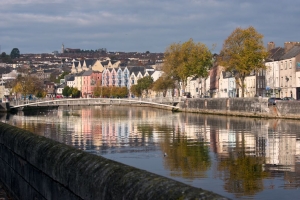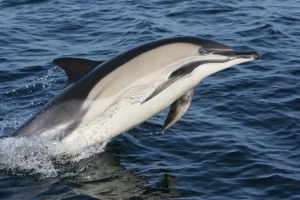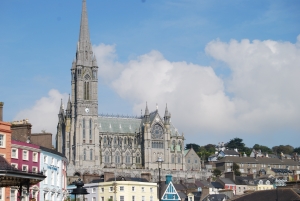8 Hour Cork Day Tour
Take the private chauffeur/guided Cork tour around the city and its suburbs with Chauffeur Ireland, visiting Blarney castle and kiss the ‘Blarney stone’ and stop in and shop at the world famous Blarney Woolen Mills. Further options include Jameson Whiskey distillery tour, The Cobh Titanic experience or even Desmond’s castle for a wine tasting experience.
Blarney: The castle originally dates from before 1200, when a wooden structure was built on the site. Around 1210 this was replaced by a stone fortification. The castle is now a partial ruin with some accessible rooms and battlements. At the top of the castle lies the Stone of Eloquence, better known as the Blarney Stone. By kissing the Blarney Stone at Blarney Castle, it is claimed that one can receive the “Gift of the Gab” (eloquence, or skill at flattery or persuasion).
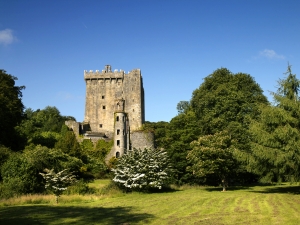
This legend has several suggested roots, some say that it was the Lia Fáil—a magical stone upon which Irish kings were crowned. Others involve members of the MacCarthy dynasty – builders and original owners of Blarney Castle. In 1314, Cormac McCarthy, King of Munster, gave Robert the Bruce of Scotland 5,000 soldiers to help him fight England in the Battle of Bannockburn; the soldiers defeated England’s King Edward II. Bruce presented the Stone of Destiny–the stone that was to become the Blarney Stone–to the McCarthy Clan. Cormac McCarthy placed the stone in the Blarney Castle’s battlement.
In 1586, Queen Elizabeth I commissioned the Earl of Leicester to take the land from the McCarthy Clan; however, the clan found ways to delay negotiations with constant delays the frustrated Queen claimed that man speaks Blarney, and the family held onto Blarney Castle. Tourists visiting Blarney Castle may hang upside-down over a sheer drop to kiss the stone.
The castle was sold and changed hands a number of times, in the early 1700s it was bought by Sir James St. John Jefferyes, then Governor of Cork City. Members of the Jefferyes family would later build a mansion near the keep. This house was destroyed by fire however, and in 1874 a replacement baronial mansion—known as Blarney House—was built overlooking the nearby lake. In the mid 19th century the Jefferyes and Colthurst families were joined by marriage, and the Colthurst family still occupy the demesne.
Blarney Woollen Mills: Built in 1823, Blarney Woollen Mills was originally known as Mahony’s Mills. It was a water powered mill, producing mainly tweeds and woollens. After closing in the early 1970s, the mills was re-invented by local entrepreneur Christy Kelleher as a gift store servicing tourists visiting the village. The centre of the village is dominated by The Square – a grass field where Blarney locals and townspeople sometimes congregate during the summer.
Cork City
The English Market: in the heart of Cork City is one of the oldest markets in Cork and a main shopping institution. The English Market in Cork is an enclosed market area where lots of fresh local produce can be purchased and where you can sit and enjoy a coffee at your leisure.
Jameson Heritage Centre: in Midleton Co. Cork will take you back through time. Discover the history, and the magical taste of Irish Whiskey -Uisce Beatha (The Water of Life) the mystical spirit perfected by Irish monks in the 6th Century A.D.
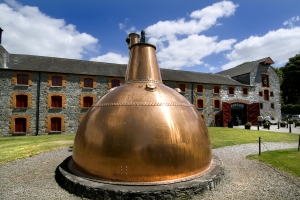
Options on the Cork Day Tour with time permitting
St. Anne’s Church Shandon is where the Shandon Bells are found. If you climb the steeple you will have the opportunity to pick a tune and play it on the bells. At the very top of St Anne’s Church you will see the weather vane which is a golden fish and the steeple also was known as the Four Face Liar due to incorrect times being displayed on all of the four side. The steeple of St. Anne’s Church was built with grey limestone on one side and the others were red limestone, in keeping with the Cork colours of Red and White!
Cork Butter Museum: Find the history of Cork’s Butter Exchange which became the largest butter market in the world from the 1700’s onwards, and with cargo ships calling into Cork butter was exchanged for spices, tea, brandy, wine and other foreign commodities. The English and Dutch favoured lightly salted butter with the West Indies and tropics favouring heavily salted butter. The butter was then duly shipped in timber crates and firkins all around the world.
Collins Barracks Military Museum: Built in the 1800’s, the Barracks is a very impressive example of Georgian Architecture built around a large parade square. The Barracks Museum proudly covers the history of Cork Barracks and its involvement in the Peacekeeping effort, and the Michael Collins era. The Barracks has a wide range of memorabilia, such as uniforms, weapons and historical photographs including the visit by the President Kennedy in the 1960’s, the 35th President of the United States of America.
Bridges on the river Lee: Patrick’s Bridge, North Gate Bridge, South Gate Bridge, Parliament Bridge, Brian Boru Bridge, Shandon Bridge, Gaol Bridge near UCC
Christy Ring Bridge, Eamon De Valera Bridge, Michael Collins Bridge, Griffith Bridge, Clarke’s Bridge, Thomas Davis Bridge, The Shaky Bridge (or Daly’s Bridge) in the Mardyke
Statues in the city: Father Mathew Statue on Patrick Street, Cork’s National Monument on the Grand Parade, Huguenots Burial Ground, Old Walls of Cork in Bishop Lucey Park, Berwick Fountain on the Grand Parade, Several sculptures in Fitzgeralds Park, Grand Parade Mooring Post
Cork City Gaol: has been restored as a highly exciting visitor attraction which set out to tell the visitor what life was like there for prisoners in the 19th century. An exciting Audio Visual presentation is an integral part of the experience, located just a short distance from Fitzgerald’s Park, UCC and Cork City centre.
Cork Lewis Glucksman Gallery: located on the wonderful grounds of University College of Cork, has won many awards for its architectural design itself. At the Gallery you will find UCC’s Art Collection along with many exhibits and pieces on display.
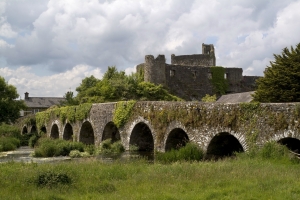
Barryscourt Castle: Consisting of a main tower house building with smaller adjacent buildings arranged around a courtyard, which was protected by an outer “bawn” or curtain wall, with 3 smaller corner towers. In the 1990s, the tower house was repaired and reroofed and is now a popular tourist heritage site. The interior is furnished as it would have been in the 16th century. The castle has daily guided tours available free of charge.
Fota House: A regency style great country house. It has been restored and offers public guided tours from 22nd March to 30th September inclusive. Discover fascinating insights into the contrasting lives of the masters of a former time and their servants in the original surroundings that shaped their worlds. Fota House hosts a range of monthly cultural events and there is always something to do there. When exploring the House a visit or guided tour of the award winning Frameyard Garden is a must.
Cobh: With panoramic views the tiny fishing village of Cobh was unknown. With the French Revolutionary and Napoleonic Wars (1792-1815), Cork Harbour became an important refueling and assembly point for naval and commercial ships. Up to 300 ships at a time could be seen at anchors in the waters of Cobh. With Queen Victoria’s visit in 1849, Cobh was renamed Queenstown in her honour. Tall ships called to transport convicts to Australia and to carry emigrants to North America. Later, the transatlantic steamers and great ocean liners continued the task of carrying the Irish to new lives in new lands. From 1848 to 1950, over 6 million adults and children emigrated from Ireland. About 2.5 million left from Cobh, making it the single most important port of emigration.
Cobh Heritage Centre: The story of Cobh’s origins, it’s unique history and legacy are dramatically recalled at The Queenstown Story – a stunning multimedia exhibition at Cobh’s restored Victorian Railway Station. Themes include The Titanic, Emigration & Famine. Explore the conditions on board the early emigrant vessels, including the dreaded “coffin ships.” Experience life on board a convict ship leaving Cove for Australia in 1801, Discover Queenstown’s special connections with the ill-fated Titanic which sank on her maiden voyage – Cobh was her last port of call. Learn about Annie Moore and her 2 brothers who left Cobh for a new life in America – Annie was the 1st immigrant ever to be processed in Ellis Island. Witness the tragic story of the Lusitania, which sank off Cork Harbour. Find out about your Irish ancestry with our Genealogy Recordfinder Service
Titanic Experience Cobh: Located in the original White Star Line Ticket Office dating back to the early 19th century and the departure point for many thousands of White Star Line passengers. Check-in with us at reception and let us tell you the story of those 123 passengers. Casement Square in Cobh town.
Camden Fort Meagher: “One of the finest remaining examples of a classical Coastal Artillery Fort in the world”. For almost 400 years the fort played a key role as a strong strategic position for the defence of Ireland, the west coast of England and Wales. 65% of the fort is located underground in a labyrinth of tunnels and chambers. The fort is a prime location to watch ships passing through Cork Harbour, the second largest natural harbour in the world. Limited opening hours – pre-call: 085 850 1483
Charles fort: A star-shaped fort with five bastions, constructed in the late 17th century on the site of an earlier coastal fortification. The two seaward bastions, the Devil’s and the Charles’ were for defending the harbour and both are casemated – that is, they have gun embrasures inside as well as on top of the walls. The North, Flagstaff and the Cockpit, are the three landward bastions and all three had a brick sentry box at their outermost point, two of these still survive. William Robinson, architect of the Royal Hospital in Kilmainham, Dublin, is credited with designing the Fort. Across the estuary is James Fort. Guided tours available.
James fort: Designed by Paul Ivy in 1602. In 1690 after the ‘Battle of the Boyne’ the Williamite forces arrived at Kinsale and attacked both forts. Guided tours available.
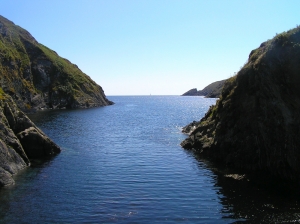
Desmond Castle: has had a colourful history, ranging from Spanish occupation in 1601 to use as a prison for captured American sailors during the American War of Independence. Desmond Castle was built by the Earl of Desmond c. 1500. A fine example of an urban tower house, the castle consists of a three storey keep with storehouses to the rear. Originally built as a Customs house, the castle also served as a prison in the 18th century (it is known locally as the French Prison) an ordnance store during the Battle of Kinsale (1601) and as a workhouse during the Great Famine. By the early decades of the 20th Century Desmond castle had fallen into decay. It was declared a National Monument in 1938. Today Desmond Castle hosts the International Museum of Wine Exhibition, an intriguing story that documents the unique history of Ireland’s wine links with Europe and the wider world. In Kinsale town, along Cork street.
Michael Collins Centre: Interpreting the life of Michael Collins, taking visitors to the important sites in West Cork associated with the famous patriot.
(*) Entry to attractions not included in tour price unless stated.
The Cork Day tour includes:
Driver/guide (1 person)
Luxury vehicle / Complimentary Wi-Fi
Complimentary water
Complimentary tour map with site details.
Advisable to bring:
Wet weather clothing
(Complimentary umbrellas available for use)
Tour Information
8 Hour Cork Day Tour
Tour Ref: CI08CDT
Tour Price: €750
Tour Duration: 8 Hours
Tour Capacity: 1 - 6 Guests
Available From: All Year
Pick Up Point:Guests Hotel
Drop Off Point:
Guests Choice
Kilometers Driven: 150 Km
Book Tour




